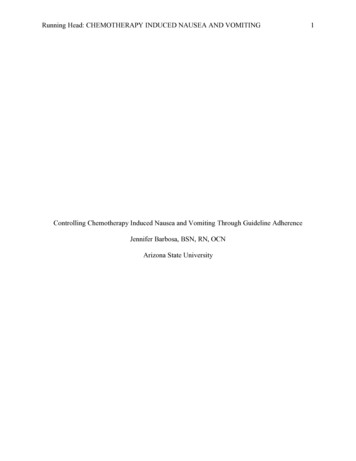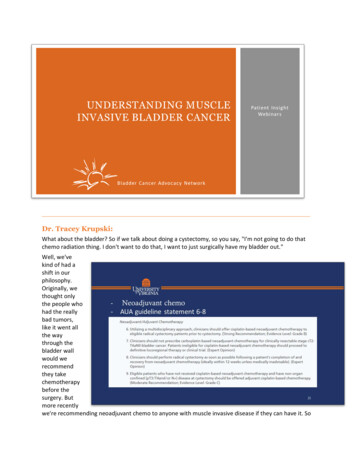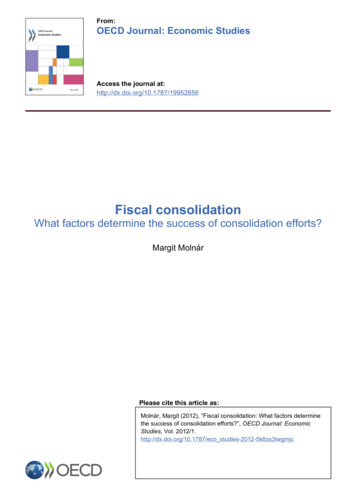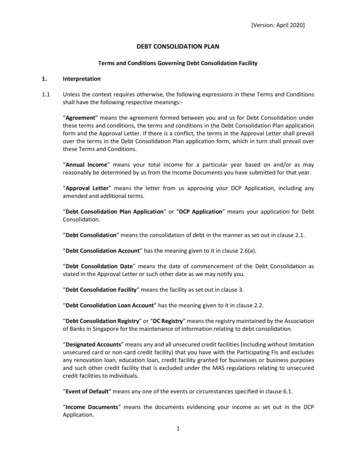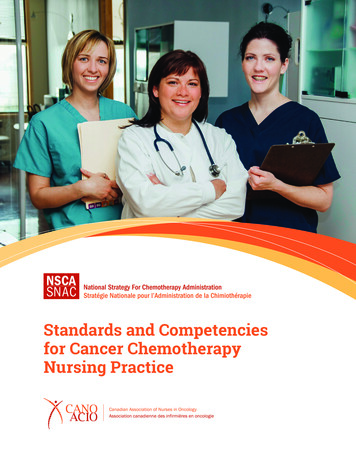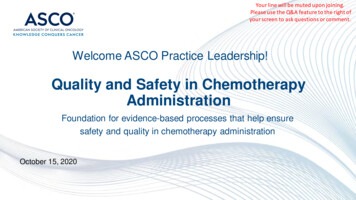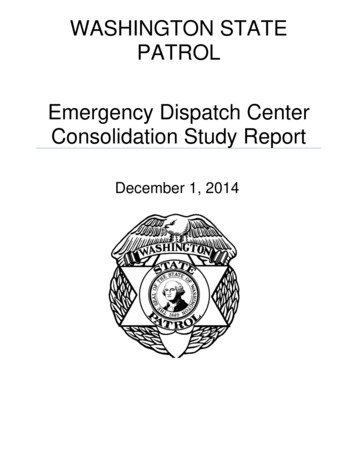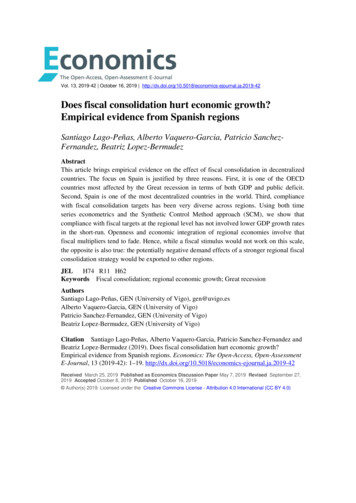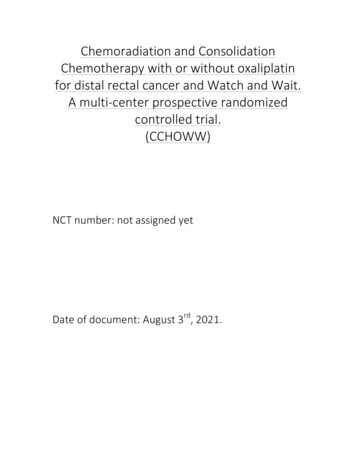
Transcription
Chemoradiation and ConsolidationChemotherapy with or without oxaliplatinfor distal rectal cancer and Watch and Wait.A multi-center prospective randomizedcontrolled trial.(CCHOWW)NCT number: not assigned yetDate of document: August 3rd, 2021.
Abstract:Background: Neoadjuvant chemoradiation (nCRT) has been considered the preferredinitial treatment strategy for distal rectal cancer. Advantages of this approach includeimproved local control after radical surgery but also the opportunity for organ preservingstrategies (Watch and Wait - WW). Consolidation chemotherapy (cCT) regimens usingfluoropyrimidine-based with or without oxalipatin following nCRT have demonstrated toincrease complete response and organ preservation rates among these patients.However, the benefit of adding oxaliplatin to cCt compared to fluoropirimidine aloneregimens in terms of primary tumor response remains unclear. Since oxalipatintreatment may be associated with considerable toxicity, it becomes imperative tounderstand the benefit of its incorporation into standard cCT regimens in terms ofprimary tumor response. The aim of the present trial is to compare the outcomes of e-aloneversusfluoropyrimidine oxaliplatin) for patients with distal rectal cancer.Methods: In this multi-centre study, patients with magnetic resonance-defined distalrectal tumors will be randomized on a 1:1 ratio to receive long-course chemoradiation(54Gy) followed by cCT with fluoropyrimidine alone versus fluoropyrimidine oxaliplatin.Magnetic resonance (MR) will be analyzed centrally prior to patient inclusion andrandomization. mrT2-3N0-1 tumor located no more than 1cm above the anorectal ringdetermined by sagittal views on MR will be eligible for the study. Tumor response will beassessed after 12 weeks from radiotherapy (RT) completion. Patients with clinicalcomplete response (clinical, endoscopic and radiological) will be enrolled in an organpreservation program (WW). The primary endpoint of this trial is decision to organpreservation surveillance (WW) at 18 weeks from RT completion. Secondary endpointsare 3-year surgery-free survival, TME-free survival, distant metastases-free survival, localregrowth-free survival and colostomy-free survival.Discussion: Long-course nCRT with cCT is associated with improved complete responserates and may be a very attractive alternative to increase the chances for organpreservation strategies. Fluoropyrimidine-based cCT with or without oxaliplatin has neverbeen investigated in the setting of a randomized trial to compare clinical response ratesand the possibility of organ-preservation. The outcomes of this study may significantlyimpact clinical practice of patients with distal rectal cancer interested in organpreservation.Keywords: rectal cancer, consolidation chemotherapy, oxaliplatin, Watch and Wait, organpreservation
IntroductionSignificant tumor response to neoadjuvant chemoradiation (nCRT) therapy has resultedin a dramatic change in distal rectal cancer management.1 Observation of near-completeand complete tumor response to treatment has led surgeons to consider organpreservation strategies to avoid the need for radical surgery. 2-5 Patients that achieveclinical complete response (cCR) defined by clinical, endoscopic and radiological criteriahave been managed non-operatively and enrolled in a strict surveillance program (Watchand Wait – WW) with acceptable oncological outcomes.6-9 These patients wouldultimately avoid the risk of immediate postoperative morbidity and mortality in additionto the potential negative consequences of urinary, sexual and anorectal functionfrequently seen after total mesorectal excision (TME).10-12 In addition, patients managedby WW would avoid the need for a temporary/definitive stoma – particularly relevantamong patients with distal tumors.13 In this latter group of patients, abdominal perinealresections (APR) with a definitive stoma or intersphincteric resections (ISR) with poorpostoperative function are the surgical alternatives.14,15Ultimately, organ-preservation has become an attractive alternative for patients withdistal rectal cancers where APR or ISR are the radical surgical alternatives. In this setting,several attempts have been made to increase chances for achieving a clinical completeresponse and allowing for the opportunity of entering an organ-preserving pathway.16Several treatment-related features may affect complete tumor regression rates toneoadjuvant strategies in rectal cancer. 17-19 There is data to suggest that specificcharacteristics of both radiation and chemotherapy may influence complete tumorregression rates. Data provided from multiple studies using different radiation doses inrectal cancer suggests that there is an increase in complete response rates as total dosesincrease.18 Radiosensitizing chemotherapy may also affect response rates to neoadjuvanttreatment strategies. Incorporation of additional chemotherapy following radiationcompletion (consolidation chemotherapy) has also shown to significantly increasecomplete clinical and pathological response rates.16,19-21 However, none of these studieswere specifically designed to compare different radiosensitizing (or consolidation)chemotherapy regimens. Regimens including exclusively 5FU-based or 5FU oxaliplatinregimens have been used in different studies using consolidation chemotherapy afterCRT completion suggesting higher rates of pCR or cCR compared to historical cohorts.19However, there has never been a head-to-head comparison between 5FU-based aloneversus 5FU-oxaliplatin in consolidation regimens. Earlier studies attempting toincorporate concomitant oxaliplatin into standard CRT regimens failed to demonstratebenefits in pCR rates while did result in excessive toxicity associated with the use ofoxaliplatin.22 However, when offered in a consolidation regimen, oxalipatin couldpotentially decrease its associated toxicity while effectively providing significant increasein response rates. For these reasons, we aimed to compare the outcomes offluoropyrimidine-only consolidation chemotherapy to fluoropyrimidine oxaliplatin inachieving a cCR after nCRT in this prospective randomized clinical trial.
Patients and MethodsPatients with distal rectal cancer will be eligible for the study after initial clinical,endoscopic and radiological assessment. At this point, patients will be offered toparticipate in the study and after informed consent, randomized to control orexperimental arms as follows.Eligibility and Inclusion CriteriaPatients will be eligible in the presence of the following inclusion criteria:1. Age 18 years;2. ECOG 0-2 or KPS 70;3. Primary rectal adenocarcinoma (biopsy confirmed) within the reach of digitalrectal examination (at least lower tip/border) by the attending colorectal surgeon;4. Endoscopic documentation;5. Abdominal and chest CT scans showing no evidence of metastatic disease;6. High-resolution magnetic resonance images performed at either 1.5T or 3.0Tsystem using a phased array surface coil with: sagittal T2 images including theanal verge and the sacrum; axial oblique T2 weighted images acquired in a planeperpendicular to the long axis of the rectal wall guided by the sagittal images;coronal images acquired in parallel to the anal canal plane. Small field of view (1618cm), 3mm section thickness, increased matrix size and increased number ofsignal averages are required;7. Radiological defining criteria (centralized):a. Lower edge of tumor at the level (max. 1cm distance) or below theanorectal ring defined at sagittal or coronal views;b. mrT2, mrT3 (any subclassification)c. mrN0-1 ( 3 radiologically positive lymph nodes)d. mrEMVI: any statuse. mrMRF: any statusExclusion criteria:1. Pregnancy2. ECOG 3 or KPS 703. Unwilling to consent4. Metastatic disease (any kind; internal iliac and obturator nodes are consideredlocal disease and not metastatic disease and therefore will not be considered asexclusion criteria)5. mrT4 or mrN26. Previous pelvic irradiation7. Baseline neuropathy8. Receiving treatment of other anti-cancer drug or methods9. Presence of uncontrolled life threatening diseases
EndpointsPrimary endpoint: Decision to Watch and Wait due to clinical complete responseachieved at 18 weeks from last date of radiation using clinical (DRE), endoscopic andradiological criteria (mrTRG grade) or near-complete clinical response (no progressivedisease clinically, endoscopically or radiologically)Definition of clinical complete response (cCR) available below and at the discretion of theattending surgeon.Definition of radiological complete response as described below (centralized).Patients will be counted as event if at 18 weeks the decision is to interrupt Watch andWait and proceed to surgery (any kind) because of overt incomplete clinical response. Inorder to standardize assessment of response and reduce inter-observer variability, thedecision to continue on Watch and Wait (or not) will be at the discretion of the centralcommittee during central revision of studies.Secondary endpoints:-Surgery-free survival at 3 yearsTME-free survival at 3 yearsDistant metastases free survival at 3 yearsLocal regrowth-free survival at 3 yearsColostomy-free survival at 3 yearsDefinitionsDefinition of cCR:- Endoscopic: white scar, teleangiectasia, absence of ulceration and/or mass 6- Clinical: no irregularity, firm area with minor induration6- Radiological: mrTRG1: fibrosis with low signal intensity seen on T2 weightedimages replacing the primary tumor; no restricted diffusion on diffusion weightedimages; no nodes with border irregularity or mixed signal intensity; no extramuralvascular invasion23-26Definition of near-complete response:- Endoscopic: residual tumor size 2cm (or reduction of 70% original tumorvolume/size) 4,27,28- Clinical: only superficial ulceration or minor (questionable) irregularities of themucosal/rectal wall- Radiological: mrTRG2 predominant fibrosis with low signal with foci ofintermediate tumor signal intensity seen on T2 weighted images with or withoutrestricted diffusion; mrTRG1: fibrosis with low signal intensity seen on T2 weighted
images replacing the primary tumor with restricted diffusion; no nodes with borderirregularity or mixed signal intensity; no extramural vascular invasion 27Central CommitteeThe central committee is multidisciplinary group of surgeons, medical oncologists andradiologists previously appointed at the beginning of the recruitment of patients and withprevious experience with organ preservation.2, 21 This group of specialist will beresponsible to assess the baseline staging and define if the patients fulfill all theinclusion/exclusion criteria prior to randomization. The committee will also beresponsible to evaluate the endoscopic and radiological tumor re-assessment studies at12 and 18 weeks from radiation completion. The definition to continue on the Watch andWait pathway or not will be at the discretion of this committee.Technical aspects of assessment tests:Suggested MR protocol:1.5T - FRFSE; TR/TE: 3300/120 (ms); slice thickness/gap: 3.0/0; Matrix: 256 x 256; NSA 8)3.0T – FRFSE; TR/TE: 8000/150 (ms); slice thickness/gap: 3.0/0; Matrix: 288 x 288; NSA 5)DWI – inclusion of a high b-value of at least 800Suggested Endoscopic assessment:Endoscopic assessment using a flexible scope (gastroscope preferred for retroflexion);direct endoscopic and retroflexion view of the primary tumor/scar; endoscopic biopsiesat discretion of participating center.Treatment arms1) RT (54Gy) plus daily concomitant capecitabine 825mg/m2 bid, followed bymFOLFOX6 or XELOX for 4 cycles (12 weeks), starting 1 week after radiotherapyended;2) RT (54Gy) plus daily concomitant capecitabine 825mg/m2 bid, followed bycapecitabine 2000mg/m2/day for 14 days in a 21 days cycle for 4 cycles (12weeks), starting 1 week after radiotherapy ended;RadiotherapyPreoperative radiotherapy will be delivered on a linear accelerator in prone orsupine position, preferably with full bladder. The use of a belly board is allowed.
Isocentric 3 or 4 fields, as well as an IMRT technique is allowed, as long as all beams aretreated on a daily basis. The dose distribution and calculation should be performed on CTor MRI and specified according to the ICRU 50 guidelines.Dose specification: All patients will receive 25 daily fractions of 1.8 Gy up to a total doseof 45 Gy to the pelvic field including the tumor bed with a margin and the regional lymphnodes. A field reduction after 45 Gy is recommended up to 54 Gy. The last 5 fractions willthen be given to the tumor bed with a margin.Target volume:Pelvic CTV- The primary tumor- Mesorectum: Distally, only lymph nodes or tumor deposits up to 4 cm areincluded. For tumors in lower rectum this means that the entire mesorectumdown to the pelvic floor is included.- Presacral nodes and nodes along the rectal superior artery: Since localrecurrences are very unusual above S1 – S2, lymph nodes above this level shouldnot be included unless there are signs of radiologically positive lymph nodespresacrally. If this is the case, the cranial limit of CTV should be at least 1 cmabove the most cranial radiologically positive lymph node.- Lateral lymph node stations: Until they reach the level of the obturator canalInternal iliac artery up to the bifurcation from the external iliac artery. The cranialborder for the CTV is in most cases just below the bifurcation of the internal andexternal iliac arteries. In most patients this is at the level of S1 – S2.- Ischio-rectal fossa and the anal canal: Included in pelvic CTV only if the tumorgrows into the levators or down into the anal canal.- Lymph nodes along the external iliac artery: Included if the tumor grows intoanterior organs like the prostate, urinary bladder, cervix, vagina or uterus to suchan extent that the external nodes are at risk for metastases.Boost GTV:GTV is the visible primary tumor and radiologically positive lymph nodes.CTV boost:GTV boost plus a margin of 2 cm within the same anatomical compartment as thetumour is in, for the dose of 45 Gy, also around radiologically engaged lymph nodes.PTV:The above description relates to the CTV. A PTV should normally be defined and includesCTV and internal target volume (ITV) and a margin necessary for the setup. Thesemargins are depending upon several factors that are related to the equipment at eachradiotherapy center.Chemotherapy Protocols
Concomitant chemotherapy:Concomitant capecitabine: 825mg/m2 bid on the radiotherapy days onlyConsolidation chemotherapy:1. Consolidation capecitabine (alone): 1000mg/m2 bid, for 14 days, in a 3 week cycle,for 4 cycles2. Consolidation options with oxaliplatin:2.1. mFOLFOX6: Oxaliplatin 85mg/m2 plus Leucovorin 400mg/m2 on a concomitant 2hours infusion. 5FU 400mg/m2 on a bolus infusion, followed by 5FU 2400mg/m2in 46 hours infusion, every 2 weeks, for 6 cycles2.2. CAPOX: Oxaliplatin 130mg/m2 on a 2 hours infusion. Capecitabine 1000mg/m2bid daily, for 14 days, starting on the evening of the oxaliplatin infusion. Repeatevery 3 weeks, for 4 cyclesToxicitiesChemotherapy toxicity and dose adjustment:Dose reduction is planned in case of severe haematological and/or non haematologicaltoxicities. Dose adjustments are to be made according to the system showing thegreatest degree of toxicity. Toxicities will be graded using the NCI CTC, version 5.0.Treatment will be delayed until: neutrophils 1.5 x 109 /L and platelets 75 x 109 /L.1) 5FU dose-modification:Recovery from mucositis, diarrhea If 5-FU treatment is delayed, then theassociated oxaliplatin dose should also be delayed. If 5-FU is discontinuedpermanently, oxaliplatin should also be discontinued. If toxicity requires adosing delay of more than four weeks, the subject will be permanentlywithdrawn from the study treatment for toxicity. Dose modifications forhematologic or GI toxicity will be based on the worst toxicity observedduring the previous cycle. After recovery, standard dose adjustments for5-FU toxicity should be applied. The dose of 5-FU should be reduced by20% in subsequent cycles for the following toxicities: febrile neutropenia,
grade 4 thrombocytopenia, or failure of hematological recovery toneutrophils 1500 /µL and platelets 75000/µL within 2 weeks of thescheduled start of the next treatment cycle; grade 3-4 mucositis, diarrhea,or nausea or vomiting in spite of optimal antiemetic prophylaxis. In themFOLFOX6 protocol, the bolus 5FU should be interrupted before theaforementioned reduction of the continuos infusion 5FU. A second dosereduction of 5-FU of 20% from the original dose may be made if the abovetoxicities recur. After reductions of doses, they should not be increasedagain and must be carried on to the rest of the treatment.2) Capecitabine:Patients with a creatinine clearance of 30-50 mL (min must commencetreatment with CAPE at 75% of the full dose. Dose modifications forhematologic, skin or GI toxicity will be based on the worst toxicityobserved during the previous cycle. After recovery, standard doseadjustments for capecitabine toxicity should be applied. The dose ofcapecitabine should be reduced by 25% in subsequent cycles for thefollowing toxicities: febrile neutropenia, grade 4 thrombocytopenia, orfailure of hematological recovery to neutrophils 1500 /µL and platelets 75000/µL within 2 weeks of the scheduled start of the next treatmentcycle; grade 3-4 mucositis, hand-foot syndrome, diarrhea, or nausea orvomiting in spite of optimal antiemetic prophylaxis.3) Oxaliplatin;If a second dose reduction of 5FU is performed, oxaliplatin dose must alsobe reduced by 25%. Oxaliplatin neurotoxicity should be assessed beforeevery oxaliplatin dose. If neurotoxicity is grade 3, oxaliplatin dose shouldbe reduced by 25%. If toxicity is grade 4, oxaliplatin should bediscontinued permanently. For oxaliplatin infusion reactions grade 2 orless occur, oxaliplatin can have its infusion time extended until 6 hoursand the patient must receive pre medications such as H1 antagonists, H2antagonists and corticosteroids. If it recurs or is graded 3 or more,oxaliplatin administration must be suspended. Where it is available,desensitization protocols can be applied, 5FU may continue even ifoxaliplatin is discontinued.RT Toxicity and Stopping RulesToxicity will be assessed and recorded according to the CTCAE v4.0 acute radiationmorbidity scoring criteria.
Table: Stopping rules for radiotherapy during chemoradiationAdverse eventDefinitionActionDiarrheaGrade 4should be interrupted until thetreatment-related symptoms havebeen reduced and parental support isno longer necessaryOther gastroIntestinal toxicityGrade 4should be interrupted and restartedaccording to the patients' conditionCTC v ctronic applications/ctc.htm#ctc 40Assessment of ResponseAssessment of response will be performed at 12 weeks (and 18 weeks from last date ofradiation therapy if cCR or near-complete response is detected at 12 weeks). All patientswill undergo endoscopic reassessment, DRE and high-resolution MR. Endoscopic biopsieswill be at the discretion of the attending surgeon/endoscopist.Patients with complete or near-complete clinical response at 12 weeks will berecommended reassessment at 18 weeks from RT. Patients with clinically overtincomplete clinical response at 12 or 18 weeks will be referred to immediate radicalsurgery.RandomizationIndividuals will be randomized and allocated at a 1:1 ratio to the two groups (control andexperimental) using a permuted block design with a random block size of 4, 6, and 8. (13)A randomization list will be generated electronically using appropriate softwareimmediately after being considered eligible.Protocol BlindingPatients and attending phisicians will not be blinded to the treatment arm randomizedfor each patient. However, as a strategy to reduce investigator’s expectations and reduceinherent bias, the central committee will be blinded to the treatment arm. It is expectedthat blinding the central committee, who will be responsible for assessing the primaryendpoint, any bias related to the investigator’s expectation about the treatment arm andthe chances of Watch and Wait will be nulled.
Sample size calculationThe primary endpoint (decision to WW due to cCR/near CR) was observed in 55% and85% at 12 weeks (in contrast to the 18 weeks used in the present trial) among patientswith early cT3 and cT2 rectal cancer respectively.29 In this study, there was a distributionof 66% of cT3 and 33% cT2. Therefore, response rates appear to be highly dependent onexact T-stage distribution. Considering the expected inclusion of more advanced disease(late mrT3 or even mrT4 rectal cancers) we expect 40% cCR/near-CR in the control arm. Asimilar difference 60% versus 40% was achieved in the preliminary report of theoutcomes of the OPRA trial. This difference in TME-free survival at 3 years wasstatistically significant favoring patients undergoing nCRT with cCT in comparison to nCRTpreceeded by induction chemotherapy (both regimens incorporating oxaliplatin). In thissetting, if experimental results in 60% cCR/near-CR, the study will be consideredPOSITIVE. The incorporation of oxaliplatin to a consolidation CRT regimen that results in 20% increase in cCR/near-CR exceeds the potential disadvantages of treatment-relatedtoxicity.The investigators will assume that the primary outcome will occur in 40% of individuals incontrol group and 60% in the experimental group, which corresponds to an absolutedifference in proportions of 20%. It is estimated that a sample of 194 (97 per group)provides 80% statistical power to detect this difference at a significance level of 5% usingthe Chi-square test and assuming a two-sided significance hypothesis and considering a1:1 allocation. The estimated dropout rate is 10% in each group, so it is expected toinclude 216 individuals (108 per group). The sample size calculation was performed usingSAS 9.4 (PROC POWER procedure).Time-tablePatient accrual: 2 years and 6 monthsPatient/institution/year: 5-6 (20 institutions: 100-120/year – 2 years n 200-240)Interim analysis:If the arm of two drugs during consolidation shows 25% response rate after 72 patients,study will be interrupted (efficacy). If the arm of two drugs shows less than 5% responserate after 72 patients, the study will be interrupted.
DiscussionComplete primary tumor regression has become a relevant endpoint in rectal cancermanagement. Achievement of a complete clinical response to neoadjuvant treatmentstrategies has provided the opportunity to avoid major abdominal surgery, its associatedmorbidity and the requirement for temporary or definitive stomas. Long-term datasuggests that nearly 70% of patients who achieve a cCR will never require radicalsurgery.5,8,9 In addition, in 30% of these patients that develop local regrowth salvageresection is successful in the vast majority of patients leading to excellent local diseasecontrol and survival.7,30In this setting, changes in neoadjuvant treatment regimens may now be driven by theattempt to increase response rates. Most studies at this point, presented nearly 25% cCRrates among centers practicing WW and using standard CRT regimens similar to theexperimental arm of the German trial (2 cycles of 5FU-based chemotherapy).9 In thissetting, several treatment alternatives have been investigated in order to improveresponse rates to allow for organ-preservation. Initial retrospective studies (beforeintroduction of total neoadjuvant therapy concept - TNT) suggested that the inclusion ofadditional chemotherapy agents (in addition to 5FU/fluoropyrimidines and concomitantto RT) to nCRT regimens would significantly increase pCR rates.17 Oxaliplatin was themost common additional chemotherapy agent added to 5FU. Unfortunately, subsequentrandomized clinical trials failed to demonstrate significant increases in pCR rates whenoxaliplatin was added to standard nCRT regimens. Instead, a significant increase intreatment related toxicity was observed.22A single phase 2 study was performed using additional cycles of bolus 5FU aimed atimproving cCR (instead of pCR) rates.16,21,29 This study incorporated 4 additional cycles ofbolus 5FU infusion (to the usual 2 cycles) to be delivered during RT but also during the“resting” period. Surprisingly, cCR rates were nearly 50% of all patients treated includingtumors with baseline T2/T3 rectal cancer. While the increase in cCR rates could havebeen attributed to the increase in number of cycles of chemotherapy delivered duringand after RT completion (“consolidation” chemotherapy even though not named as suchat the time), one additional change in the regimen could have also contributed to theincrease in cCR rates: RT dose escalation was also incorporated to this nCRT regimen(50.4Gy to 54Gy). Therefore, it became impossible to establish a direct cause-effectrelationship between cCR rates and consolidation chemotherapy or RT dose-escalation.Another prospective non-randomized study also suggested the potential effects ofconsolidation chemotherapy to response in rectal cancer. The “timing” trial includedpatients with locally advanced disease into 4 different arms (sequentially, notrandomized).20,31,32 The primary objective of the study was to investigate progressivelonger interval periods between RT completion and surgery in response: 6, 12, 18 and 24weeks. However, patients included in the 12, 18 and 24 received consolidationchemotherapy with mFOLFOX (2,4 and 6 cycles respectively) resulting in significantincreases in pCR rates (pCR 25%, 30% and 38% respectively) compared to noconsolidation chemotherapy (pCR 18%). Again, while the increase in pCR rates could have
been attributed to the increase number of chemotherapy cycles (consolidation), theeffect of prolonged intervals in time could also have contributed to this observation.Finally, with the introduction of the TNT concept – providing adjuvant chemotherapyimmediately before nCRT (induction) or after nCRT (consolidation), initial experiences(using FOLFOX as consolidation) suggested an increase in complete response and in thechances of organ preservation among these patients.33 One prospective randomizedstudy (OPRA) presented the preliminary outcomes of the comparison between inductionand consolidation chemotherapy (FOLFOX). While there was no difference in 3-yr diseasefree survival rates between arms, organ-preservation rates was significantly better forconsolidation chemotherapy when compared to induction chemotherapy.In summary, there is evidence to support that consolidation chemotherapy maycontribute to improve response rates in rectal cancer following nCRT. Both 5FU-only and5FU/Oxaliplatin-based chemotherapy consolidation regimens have shown promisingresults.20,34 However, no study addressed the benefit of oxaliplatin during consolidationto improve response rates. While previous studies incorporating oxaliplatin werenegative and associated with increased toxicity, all of these studies used oxaliplatin inconcomitance to RT.For these reasons, we decided to design a study to address the impact of 2 differentconsolidation chemotherapy regimens in complete primary tumor response to treatmentin rectal cancer.35 The findings of the present study may allow for a definitiverecommendation of specific consolidation regimens, particularly when the primarypurpose of the use of neoadjuvant therapy is to achieve a complete clinical response andoffer organ-preservation to these patients.
References1.Kosinski L, Habr-Gama A, Ludwig K, Perez R. Shifting concepts in rectal cancermanagement: a review of contemporary primary rectal cancer treatment strategies. CACancer J Clin 2012; 62(3): 173-202.2.Habr-Gama A, Perez RO, Nadalin W, et al. Operative versus nonoperativetreatment for stage 0 distal rectal cancer following chemoradiation therapy: long-termresults. Ann Surg 2004; 240(4): 711-7; discussion 7-8.3.Garcia-Aguilar J, Renfro LA, Chow OS, et al. Organ preservation for clinical T2N0distal rectal cancer using neoadjuvant chemoradiotherapy and local excision (ACOSOGZ6041): results of an open-label, single-arm, multi-institutional, phase 2 trial. LancetOncol 2015; 16(15): 1537-46.4.Rullier E, Rouanet P, Tuech JJ, et al. Organ preservation for rectal cancer(GRECCAR 2): a prospective, randomised, open-label, multicentre, phase 3 trial. Lancet2017; 390(10093): 469-79.5.van der Valk MJM, Hilling DE, Bastiaannet E, et al. Long-term outcomes of clinicalcomplete responders after neoadjuvant treatment for rectal cancer in the InternationalWatch & Wait Database (IWWD): an international multicentre registry study. Lancet2018; 391(10139): 2537-45.6.Habr-Gama A, Perez RO, Wynn G, Marks J, Kessler H, Gama-Rodrigues J. Completeclinical response after neoadjuvant chemoradiation therapy for distal rectal cancer:characterization of clinical and endoscopic findings for standardization. Dis Colon Rectum2010; 53(12): 1692-8.7.Dossa F, Chesney TR, Acuna SA, Baxter NN. A watch-and-wait approach for locallyadvanced rectal cancer after a clinical complete response following neoadjuvantchemoradiation: a systematic review and meta-analysis. Lancet Gastroenterol Hepatol2017.8.Chadi SA, Malcomson L, Ensor J, et al. Factors affecting local regrowth after watchand wait for patients with a clinical complete response following chemoradiotherapy inrectal cancer (InterCoRe consortium): an individual participant data meta-analysis. LancetGastroenterol Hepatol 2018; 3(12): 825-36.9.Dattani M, Heald RJ, Goussous G, et al. Oncological and Survival Outcomes inWatch and Wait Patients With a Clinical Complete Response After NeoadjuvantChemoradiotherapy for Rectal Cancer: A Systematic Review and Pooled Analysis. AnnSurg 2018; 268(6): 955-67.10.Lange MM, Maas CP, Marijnen CA, et al. Urinary dysfunction after rectal cancertreatment is mainly caused by surgery.
versus 5FU-oxaliplatin in consolidation regimens. Earlier studies attempting to incorporate concomitant oxaliplatin into standard CRT regimens failed to demonstrate benefits in pCR rates while did result in excessive toxicity associated with the use of oxaliplatin.22 However, when offered in a consolidation regimen, oxalipatin could
